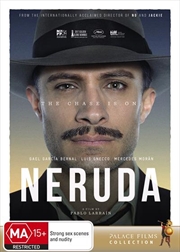Neruda (2016) |
|
Neruda (2016) |
|


|
| BUY IT |
| General | Extras | ||
| Category | Drama |
Theatrical Trailer Trailer-More from Palace Films x 4 |
|
| Rating |

|
||
| Year Of Production | 2016 | ||
| Running Time | 103:25 | ||
| RSDL / Flipper | Dual Layered | Cast & Crew | |
| Start Up | Menu | ||
| Region Coding | 1,2,3,4,5,6 | Directed By | Pablo Larraín |
|
Studio
Distributor |
 Madman Entertainment |
Starring |
Luis Gnecco Mercedes Moran Gael Garcia Bernal Pablo Derqui Michael Silva |
| Case | Alpha-Transparent | ||
| RPI | ? | Music | Federico Jusid |
| Video | Audio | ||
| Pan & Scan/Full Frame | None | Spanish Dolby Digital 5.1 (448Kb/s) | |
| Widescreen Aspect Ratio | 2.35:1 | ||
| 16x9 Enhancement |
 |
||
| Video Format | 576i (PAL) | ||
| Original Aspect Ratio | 2.35:1 | Miscellaneous | |
| Jacket Pictures | No | ||
| Subtitles | English (Burned In) | Smoking | Yes |
| Annoying Product Placement | No | ||
| Action In or After Credits | No | ||
In 1948 President Videla of Chile declared the Communist Party illegal, rounding up and gaoling party members. This forced Pablo Neruda (Luis Gnecco), Senator, poet, novelist, Communist and critic of the President, and his artist wife Delia (Mercedes Moran) underground, living with supporters while still publishing pamphlets denouncing the President. The regime appointed Policeman Oscar Peluchonneau (Gael Garcia Bernal) to hunt Neruda down, capture and humiliate him. But Neruda, never one to hide his light away, leaves copies of novels for Oscar to read whenever he gets close. For, as Neruda reinvents his own life on the run, he also invents Oscar.
Neruda is directed by Chilean Pablo Larrain, who had previously delved into recent Chilean political history with No (2012); the same year as Neruda he also released the English language film Jackie. Neruda is not a biography of the Nobel Prize winning poet in any sense, nor is the portrayal of Neruda particularly flattering; he is a womaniser, hedonist, egotist and very much a bourgeois despite his communist sentiments. Rather, in Neruda, Larrain has crafted a fascinating film about the nature of art itself, blurring the line between fiction and reality; for is life art or is art life? Can life be rewritten as if it is, indeed, a novel with main and supporting characters? These questions are enclosed by Larrain within one of the oldest plots going around; the hunt for a fugitive.
Much of the ambiguity in the film comes about as the character Peluchonneau provides a running narration of things he knows, and things he cannot possibly know, as if he is writing a script, at other times his thoughts and those of others are interposed over dialogue and while the film overall has a chronological timeline various scenes are jumbled together to provide thoughts and different perspectives of a conversation. On the surface Peluchonneau, trying to live up to a famous policemen father who never acknowledged him, is reinventing himself but Neruda is also rewriting the character of the man who is chasing him until the narrative climaxes in the snows of the Andes. The cinematography of DP Sergio Armstrong is also part of the plan. Some scenes, such as the glorious snow covered Andes, detailed drawing rooms or city streets are visually stunning, but for much of the film scenes have obvious varying contrast and brightness, glare and lens flares reminding the audience that what they are watching is not real.
Neruda is a complex and ingenious film with a fine script and excellent performances by Luis Gnecco, Mercedes Moran and especially Gael Garcia Bernal, in the most complex part. What is real and what is art? In the last scene of the film, as one should expect from what went before, the question remains unanswered.
Neruda is presented in the original 2.35:1 aspect ratio and is 16x9 enhanced.
It is hard to score the video presentation in any meaningful way. When Neruda wants to be it is sharp with strong detail in interior rooms, the streets of the city and the snow covered Andes. But, as noted, the film has obvious varying contrast and brightness, glare and lens flares, which obscure detail and, indeed, shadow detail. Colours are glossy but generally muted as well, also looking very yellowish at night under lights. Blacks are however solid and I noticed no marks or artefacts.
The layer change at 58:15 created a slight pause just after a scene change.
There are white, burnt in, English subtitles. They were error free.
| Sharpness | |
| Shadow Detail | |
| Colour | |
| Grain/Pixelization | |
| Film-To-Video Artefacts | |
| Film Artefacts | |
| Overall |
The audio is a Spanish Dolby Digital 5.1 track at 448 Kbps, with some dialogue in French.
All dialogue sounded clear. This is not a film that requires a loud or overly enveloping audio track; effects, such as shots, were crisp and the rears and surrounds featured ambient sounds such as voices during arrests and crowds, engines and rain, plus the music. The subwoofer supported the music and thunder, which was all that was required. The principal score by Federico Jusid was supported by music by Carlos Cabezas; it was quite dramatic. Some Edvard Grieg was also added.
Lip synchronisation was fine.
| Dialogue | |
| Audio Sync | |
| Clicks/Pops/Dropouts | |
| Surround Channel Use | |
| Subwoofer | |
| Overall |
Trailers for Things to Come (2:11), Land of Mine (2:01), Truman (1:37) and Embrace of the Serpent (2:19).
NOTE: To view non-R4 releases, your equipment needs to be multi-zone compatible and usually also NTSC compatible.
The Region 2 UK version of Neruda includes as an extra BFI interviews with Pablo Larrain and Gael Garcia Bernal which are not present on our release or the Region 1 US release.
Neruda was presented during the Director’s Fortnight at Cannes and was Chile’s official entry for Best Foreign Language film at the 2017 Oscars. Neruda is not a film for those who like their narrative straightforward and everything resolved; it is a wonderful, complex film, beautifully constructed and beautifully acted, so that the answers to questions about the relationship between art and life remain ambiguous. This is World Cinema of a very high order.
The video is as the filmmakers intended, the audio fine. A trailer and trailers for other films are the only extras.
| Video | |
| Audio | |
| Extras | |
| Plot | |
| Overall |
| Review Equipment | |
| DVD | Sony BDP-S580, using HDMI output |
| Display | LG 55inch HD LCD. This display device has not been calibrated. This display device is 16x9 capable. This display device has a maximum native resolution of 1080p. |
| Audio Decoder | NAD T737. This audio decoder/receiver has not been calibrated. |
| Amplification | NAD T737 |
| Speakers | Studio Acoustics 5.1 |